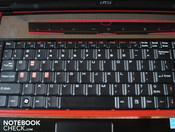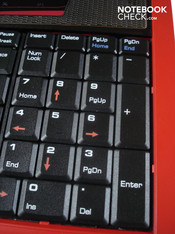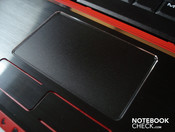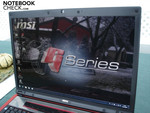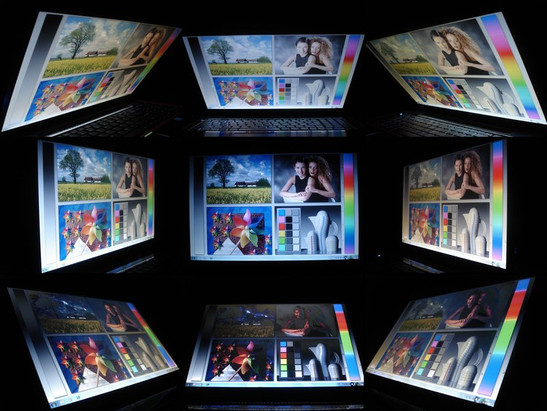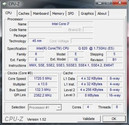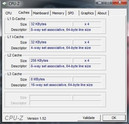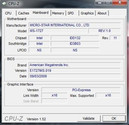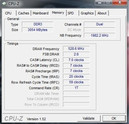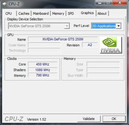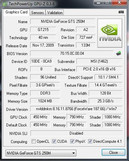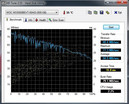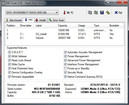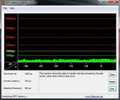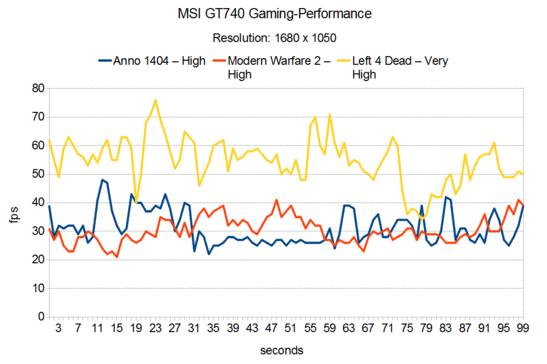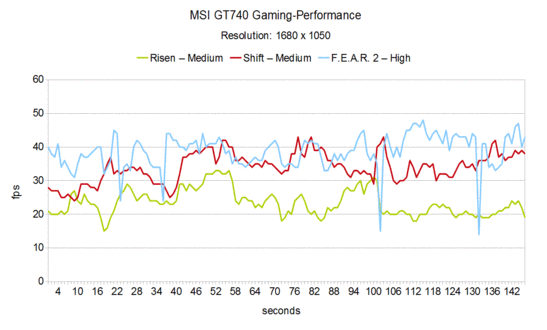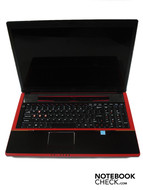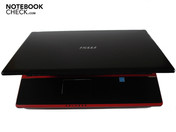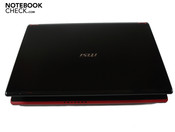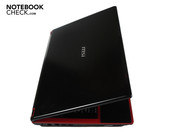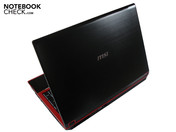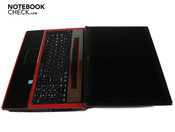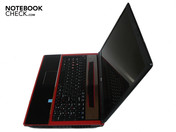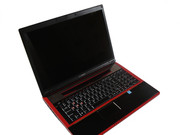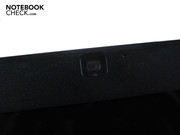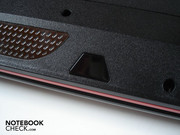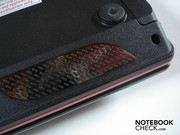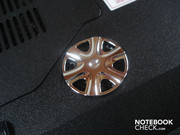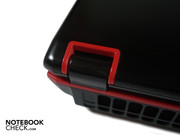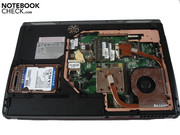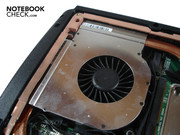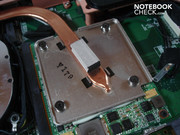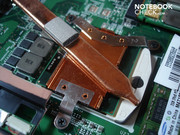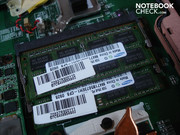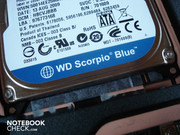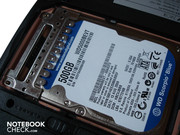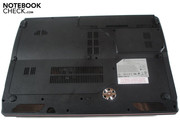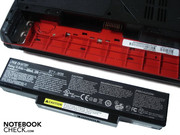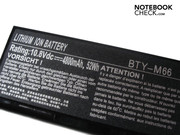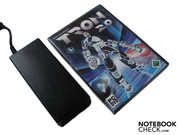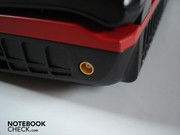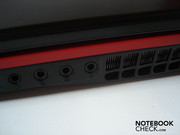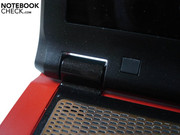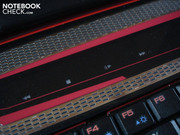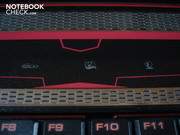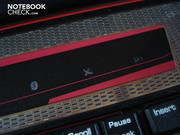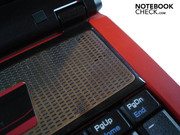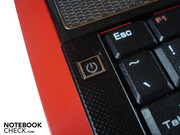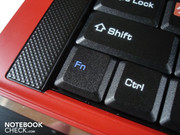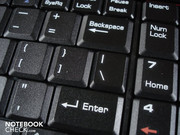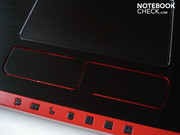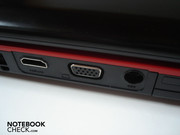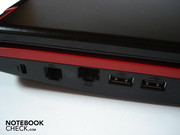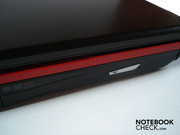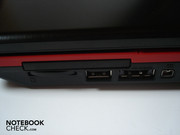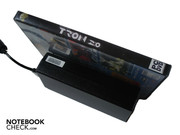Review MSI GT740 Gaming Notebook
A Gamer's Desire?
MSI releases the newest offshoot of its gaming range with the GT740. The 17 inch notebook has state-of-the-art components with the Core i7 820QM and a GeForce GTS 250M and wants to thus win gamers despite a steep price of around 1450 euro. Read in our comprehensive review if the supplied performance is impressive and MSI's notorious weaknesses have been mended in the meantime.
Alike its little brother, the GT640 (15.4 inch), the currently only available model of the GT740 (GT740-i7247W7P) has a GeForce GTS 250M from Nvidia and a Core i7 720QM from Intel. MSI has equipped our prototype with the somewhat stronger Core i7 820QM right away, though. A four GByte DDR3 RAM with 1066 MHz supply the necessary reserves, the integrated 500 GByte hard disk provides decent memory capacities. Last but not least, the GT750 that costs around 1450 euro is predestined as a desktop replacement due to its 17 inch display size.
If you're not willing to spend so much money, you can take one of the 15.4 inch models, GT628 or GX623. The GX623 costs between 800 and 1000 euro depending on the configuration. The processor bandwidth ranges from a Core 2 Duo T6500/T6600 (2,16/2,2 GHz, 800 MHz FSB and 2 MByte L2-Cache each), over the P7350 (2,00 GHz, 1066 MHz FSB, 3 MByte L2-Cache) up to the P8700 (2,53 GHz, 1066 MHz FSB, 3 MByte L2-Cache). The Random Access Memory has a capacity of four GBytes, the hard disk has a size of 320 or 500 GBytes. ATI's Radeon HD 4670 is relied on as the graphic card, which is still an absolute value for money tip amongst the graphic cards.
The GT628 is a bit more expensive with 1050 to 1250 euro but has the stronger GeForce GTS 160M. You can choose between the Core 2 Duo P8700 (2.53 GHz, 1066 MHz FSB, 3 MByte L2-Cache) or the Core 2 Quad Q9000 (2.00 GHz, 1066 MHz FSB, 6 MByte L2-Cache) as the processor. Again, the RAM has a capacity of four GBytes, the hard disk supplies a capacity of 500 GBytes.
Case
MSI's gaming notebooks have always distinguished themselves with their striking fiery red accents and matt surfaces of black, brushed aluminum. In this manner, an elegant and very high-quality impression is created and the surfaces smudge far less obviously than notebooks with a high-gloss finish. In return, the general stability provides reason for complaint and proves to be not much better than the smaller and thus more delicate GX623, GT628 and GT640 models in comparison. The display lid can be depressed quite decently in the center and selective image distortions could turn up at stronger contact. The rest of the chassis can be induced to a palpable yielding both in the wrist rest's center as well as in the center of the touch sensitive touch bar. In return, the notebook's base is very stable and proves to be resistant even under greater torsional force.
The GT740 isn't especially compact due to its 17 inch display and its size of 395 x 278 x 40 mm (width x depth x height) but it is surprisingly light with its relatively low weight of 3150 grams. Finally, we'll dedicate ourselves to the hinges: Both small hinges are astonishingly stable and need a concerted measure of force, but entice the case to an evident lifting.
Connectivity
As usual for MSI, the connectivity turns out very generous. On the left, a Kensington lock, a RJ-11 modem, a RJ-45 gigabit LAN port and two USB 2.0 connections are found. The left is rounded off by a multinorm DVD burner. The front remains unfettered from any connections, merely an inconspicuous infrared receiver has been placed here. The right has an ExpressCard slot, a 4-in-1 cardreader (XD, SD, MMC, MS), an USB 2.0, an eSATA/USB 2.0 combo (which adds up to a total of 4 USB 2.0) and Firewire. Four audio sockets, which aren't marked by color, also join in (microphone, headphone, line-in, line-out) and a rather rare antenna-in. Finally, the rear provides an HDMI, VGA and the DC-in.
We quite liked the port distribution on the rear and on the left, but the audio sockets and USB ports on the right have been placed a bit too far front for our taste. In our opinion, the RJ-45 gigabit LAN port would also have been better placed on the rear. Generally, MSI has done a good job and distinguishes itself with its comprehensive interface variety from the competition.
The customer is supplied with Bluetooth (2.0) and WLAN (802.11 b/g/n) on the wireless side. Otherwise, an integrated microphone and a webcam with a resolution of 2.0 megapixels are included.
Software
In opposition to other manufacturers, like Acer or Sony, MSI has majorly waives peeving bloatware and has kept the GT749's software installation agreeably thin (except for a package from ArcSoft). Thus, the customer doesn't have to spend a long time uninstalling them and already has a quick system at the state of delivery. Of course, MSI's so-called "ECO Engine Power Management System" is also on board again. You can select one of five different scenes, such as gaming, office or movies, with a simple push of a button. The "Eco" mode is intended to increase the battery life. This is supposed to be achieved by adjusting the display brightness and processor performance, among other things.
Input Devices
Keyboard
The poor keyboard is the biggest critique point of the GT740. The keyboard already yields extremely at low pressure and has an unbelievably indistinct and unclear pressure point. Additionally, MSI has tampered with the tested and proved standard layout and has "de-improved" it to suit its taste. Above that, a few key have turned out disagreeably narrow. The peak of incomprehension: MSI has placed the FN key left of the Crtl key. Especially in games, you hit the wrong key in the heat of the moment this way. On the whole, we couldn't get used to MSI's unconventional keyboard, even after several days; even after a longer accommodation period you still persistently hit the wrong key.
Touchpad
The touchpad in the case's color presented itself considerably better. Its smooth surface guarantees optimal gliding traits. We also came to appreciate its reliability and its high precision. The touchpad is well sized horizontally; it could have used a bit more place vertically, though. Because the touchpad is slightly submerged and enclosed in a glossy silver bezel, both a good optical as well as a haptical orientation is achieved. Unfortunately, MSI has placed the touchpad a bit too far left with the result that it's often triggered unintentionally, especially during gaming. Fortunately, the touchpad can be disabled via a FN key combination.
Both touchpad keys have been milled into the wrist rest, which looks good on the one side, but various dirt particles in the constructional related gap are collected quickly, on the other.
Display
Opposing the common trend, MSI builds in a display of the "old" 16:10 format. The GT740's 17 inch display has a resolution of 1680 x 1050 pixels. The contrast of 690:1 is excellent. Even the black value of 0.23 cd/m2 can be denoted with "very good". But the praise ends here because the other values aren't by far worth referring to. The illumination of 61% proves to be average and the luminosity disappoints completely with an average of 147.9 cd/m2.
Subjectively, we found the image exceedingly pallid and the colors were very dull. No matter if office, movies or games, you always have the urge to adjust the brightness even further than the maximum possible rate. You ask yourself in view of such weak colors, if the highly praised glossiness of this display has any practical value in this respect...
| |||||||||||||||||||||||||
Brightness Distribution: 61 %
Contrast: 690:1 (Black: 0.23 cd/m²)
The viewing angles are overall alright. Larger angles are needed on the horizontal plane in order to see image changes. In return, brightness differences and color deviations turn up quicker on the vertical plane. The viewing angle stability is a bit better in comparison to the recently tested MSI GT640.
Performance
Apparently MSI just wanted the best for its processor and thus selected the Core i7 820QM. Intel's newest mobile CPU generation is manufactured in a cutting edge 45 nm process and serves with numerous features. Amongst others, the so-called "Turbo Boost" technology belongs to it. With its assistance, the processor overclocks itself from its standard 1.73 GHz up to 3.06 GHz under load. However, an efficient cooling is required. For another, "Hyper Threading" provides four additional cores via simulation, with which the Core i7 820QM pretends to be an eight core CPU (can be seen in the task manager). Above that the customer doesn't only get a 1 MByte L2 cache, but also an 8 MByte L3 cache. The TDP of 45 watts is considerable so that the Core i7 isn't suitable for notebooks with a focus on long a battery life.
Even more, the main memory is a four GByte DDR3 RAM that has a clock rate of 1066 MHz. Incomprehensible: Merely the 32 bit version of Windows 7 Home Premium is used as the operating system. Thus, there are "only" about three GBytes of the RAM available in practice.
The GeForce GTS 250M hasn't been on the market long yet and does its job as a graphic card in the GT740. The GeForce GTS 250M is based on the GT215 core (according to Nvidia, it's related to the GTX 200 desktop architecture) and is manufactured in a 40 nm structure width. The video memory has a capacity of 1024, whereas the memory accessibility is only a scanty 128 bits. This flaw is partly evened out by the optional GDDR5 memory, but most manufacturers currently still use the slower and likely cheaper GDDR3 memory. The GDDR5 memory's clock rate is up to 500 MHz (core), 1250 (shader) and 1600 MHz (memory). MSI contrarily clocks its GeForce GTS 250M with 450 MHz (core), 790 MHz (shader) and 1080 MHz (memory). Otherwise, the GeForce GTS 250M also has 96 stream processors and supports Direct X 10.1, CUDA and PhysX. Thanks to the "Pure Video HD" technology, the CPU is unloaded at computing high resolution video material. The GeForce GTS 250M's power consumption can be called moderate with 28 watts.
The Core i7 is unbeatable in the application benchmarks, at the moment. The 820QM received 3324 points in single-core and 8680 points in multi-core rendering of Cinebench R10. The manufacturer's previous favorite, the Core 2 Quad Q9000 (2.00 GHz, 6 MByte L2-Cache, 1066 MHz FSB) has to admit defeat with 2386 points in single-core and 8267 points in multi-core rendering. Nevertheless, the negative effect of the 32 bit operating system becomes obvious: Other notebooks with Core i7 easily achieve over 10000 points in multi-core rendering. Even so, the Core i7 820QM achieves an excellent 5540 points in PCMark Vantage.
| PCMark Vantage Result | 5540 points | |
Help | ||
The GeForce GTS 250M feels very much at home with the synthetic gaming benchmarks. It's on the same level, with 14775 points, as the GeForce GTX 260M (14742 points) in 3DMark 05. The Radeon HD 4670 lies a bit behind with 12614 points. In 3DMark 06 the "hierarchy" shifts and the GeForce GTS 250M places itself with 7484 points only slightly above the Radeon HD 4670 (6995 points). The GeForce GTX 260M achieves almost 10000 points. The GeForce GTS 250M positions itself with a good 3618 points between the Radeon HD 4670 (3005 points) and GeForce GTX 260M (4824 points) in 3DMark Vantage.
| 3DMark 05 Standard | 14775 points | |
| 3DMark 06 Standard Score | 7484 points | |
| 3DMark Vantage P Result | 3618 points | |
Help | ||
MSI remains loyal to its tradition and equips the GT740 with a 500 GByte hard disk out of Western Digital's fast Scorpio Blue range. The tool, HDTune, certifies that the SATA hard disk has good rates. The transfer rates move in the field of 40.4 up to 77.3 MB/s and reach a respectable average of 58.9 MB/s. The access rate (16.8 ms) and throughput rate (79.1 MB/s) proved to be normal.
Allow us to express it this way: Windows 7's performance index isn't exactly a friend of "normal" HDDs. No matter how fast a hard disk might be the rates barely ever exceed 6.0 points (maximum rate - 7.9). First SSDs can achieve higher points in this regard. The GT740 isn't an exception. With the hard disk's rate of 5.8 points, the total rating is "only" 5.8. The processor (7.2 points) and the RAM (7.4 points) score the highest and the graphic card has a slight disadvantage with 6.5 points each.
If the latencies of a notebook are too high, it can come to problems at connecting external devices (for example sound crackling with sound cards). In order to prevent unpleasant surprises, we checked the latencies under Windows with assistance from the DPC Latency Checker Tool. Conclusion: The GT740 proves to be exemplary; the latencies never surpass a rate of 500 µs.
Verdict: Especially the Core i7 provides plenty of performance. Not at least applications optimized for several cores can benefit strongly from its efficient architecture and its state-of-the-art features like "Turbo Boost" and "Hyper Threading". The 820QM even heaves the most demanding tasks effortlessly. Sustainability is thus a priority with the Core i7. The graphic card does well and places itself in the middle of the Radeon HD 4670 and the GeForce GTX 260M. Now we'll take a closer look, if this ranking order will also remain in practical gaming.
Because we've previously made the experience with other notebooks (e.g. MSI GT640, Acer Aspire 8940G) that the performance of the GeForce GTS 250M (GDDR3) strongly breaks in disproportionately with enabled image enhancements, we waive antialiasing and anisotropic texture filtering in the native resolution right from the start.
Anno 1404
The new building strategy reference Anno 1404 has been rewarded with numerous Awards in the German Game Developer Award 2009. Amongst others, "Best Game", "Best Game Graphics", Best Game Design" and "Best Soundtrack". The GeForce GTS 250M had a lot to chew on with Anno 1404 in our benchmark. Anno jolted along unplayable with 24.2 fps in the resolution of 1280 x 1024, very high details and 4x AF. In comparison: The Radeon HD 4670 is slightly slower with 22 fps, the GeForce GTS 260M is a lot faster with 42 fps. Anno was reasonably playable in the native resolution of 1680 x 1050, high details and disabled anisotropic filtering with 31.3 fps.
Modern Warfare 2
Modern Warfare 2 is currently providing for negative headlines after all the rating laurels. The general terms of service ("dedicated servers") from many providers is being breached because any gamer can be used as a server in the practice. A few users, especially in the USA, have already been warned by the providers. It'll have to be seen if the developer, Infinity Ward, has a ready-made solution. Modern Warfare 2 has to prove itself at a resolution of 1024 x 768, medium details and 2x AA: 47.5 fps advocate a smooth refresh rate. ATI's Radeon HD 4670 computes just as fast with 47.5 fps. Modern Warfare ran agreeably smooth with 36.2 fps in the native resolution, high details and disabled antialiasing.
Left 4 Dead
Although many users have announced a boycott because of the addon characters, Left 4 Dead 2 is selling itself astonishingly well. The predecessor, Left 4 Dead (1) also ran astonishingly well on MSI's GT740. 100.2 fps at a resolution of 1024 x 768 and very high details are more than impressive. Because the zombie mob is distributed coincidentally in every runthrough and the average refresh rate can thus fluctuate extremely, we won't compare it with other graphic cards. The notebook even presented a good show with 52.5 fps at a resolution of 1680 x 1050 and high details.
Crysis
In the meantime, Crysis is over two years old, but still optically leaves its competitors easily behind, anyway. The beautiful graphic has its price, though: Crysis jolts notably with 21.9 fps in the CPU and 24.9 fps in the GPU benchmark at a resolution of 1024 x 768 and high details. The Radeon HD 4670 proves to be a bit faster with 23 fps in the CPU and 28 fps in the GPU runthrough. The GeForce GTX 260M clearly takes a lead with 36 fps in the CPU and 38 fps in the GPU benchmark. We reduced the details to a medium level in the native resolution. The results were a scanty 25.5 fps in the CPU and 26.8 fps in the GPU runthrough.
Risen
With over 100,000 sold copies, Risen is the most successful role game 2009 (at least in Germany). The GeForce GTS 250M proved to be less successful with Risen. Risen was playable with 35.5 fps at a resolution of 1024 x 768, medium details and 2x AF, but wasn't really smooth. The GeForce GTX 260M felt more comfortable with 41.3 fps. Risen was even disagreeable at a resolution of 1680 x 1050, medium details and disabled anisotropic filtering due to 23.7 fps. Thus, the user hasn't any other choice but to reduce the detail level AND the resolution.
Shift
The GeForce GTS 250M copes a bit better with EA's newest race game coup, Need for Speed Shift. The super sport cars can race around the demanding laps without difficulties at a resolution of 1024 x 768, medium details and 2x AA with 38.8 fps. The GeForce GTX 260 surprisingly falls behind with 34 fps. In order to grant a smooth refresh rate in the native resolution, you'll have to fall back on medium details settings: 34.0 fps are the result without antialiasing.
F.E.A.R. 2
After witty (No one lives forever 1&2) and graphically, as well as in gaming, unique shooters (Tron 2.0), the developer Monolith has now devoted itself to scary horror shooters (F.E.A.R. 1-2). The GeForce GTS 250M proves to be unimpressed and achieved a good 44.2 fps at a resolution of 1280 x 1024, high details and 2x AA. Both the Radeon HD 4670 (52 fps) as well as the GeForce GTX 260M (69 fps) managed to top it, though. F.E.A.R. 2 still ran quite smoothly with 38.9 fps at a resolution of 1680 x 1050 and high details (no AA).
DIRT 2
Just released on the market, we snatched the probably most beautiful race game of all times, Dirt 2, and let it loose on the MSI GT740. The integrated benchmark ran "only" fairly smooth in high details and the native resolution with 29.3 fps. The situation improved in medium details to 34.9 fps.
Verdict: Theoretically, Intel's Core i7 820QM is capable of conjuring every game available on the market smoothly onto the screen in the highest settings. Unfortunately, the integrated GeForce GTS 250M proves to be a bottleneck and evidently pulls the real gaming performance down. Thus, the notebook is often overtaxed with tracks in high details in its native resolution of 1680 x 1050. First, a reduction of resolution and/or the details provide for an improvement in form of smooth refresh rates. Thus, the GT740's given gaming performance isn't exactly lush for a steep price of 1450 euro. Notebooks with a Radeon HD 4670 at half the price are barely slower in most games. This way, the Core i7 820QM seems just wasted, as it can't even close develop its full potential. Fans should therefore preferably stay far clear of notebooks with a GeForce GTS 250M and take representatives that can at least serve with a GeForce GTX 260M.
Emissions
System Noise
The GT740 already attracts attention in idle mode with 35.1 - 35.8 dB(A), whereas the hard disk also reaches 35.8 dB(A). The soundscape increases to a very audible, but not yet annoying 37.6 dB(A). The drive rotates the loudest with 38.1 dB(A) at DVD rendering. In comparison to other gaming notebooks, the GT740 positions itself in the center field in terms to noise development. All evaluations were made at a distance of 15 cm.
Noise level
| Idle |
| 35.1 / 35.8 / 35.8 dB(A) |
| HDD |
| 35.8 dB(A) |
| DVD |
| 38.1 / dB(A) |
| Load |
| 37.6 / 37.6 dB(A) |
 | ||
30 dB silent 40 dB(A) audible 50 dB(A) loud |
||
min: | ||
Temperature
Both the upper side with a maximum of 28.1°C as well as the bottom side with a maximum of 31.2°C remains surprisingly cool when the notebook doesn't have much to do (two hours operating with max. energy savings options). The upper side temperature rises evidently as soon as the demand increases (one hour Furmark + Prime95) up to 42.9°C. The right side gets lukewarm with a maximum of 35.8°C, which is still alright. The bottom side warms up extremely under load with up to 55.6°C (back right, in the fan's area).
The Core i7 has already proved to be hot-headed in previous tests. Whilst the 820QM's temperature is still completely reasonable in idle mode with around 50°C, a partly alarming high 100°C is reached under full load (several hours of Prime95 + Furmark). Because of this, the processor sometimes clocks down to 1500 - 1600 MHz. We can reassure you in consideration of this, as these situations with such a load don't actually turn up in normal gaming routine. In any case, no performance break occurred during our benchmark marathon of several hours.
The graphic card isn't a problem, either. The GeForce GTS 250M is well-tempered with about 40°C in idle mode; a uncritical 77°C is reached under full load.
(±) The maximum temperature on the upper side is 42.9 °C / 109 F, compared to the average of 40.4 °C / 105 F, ranging from 21.2 to 68.8 °C for the class Gaming.
(-) The bottom heats up to a maximum of 55.6 °C / 132 F, compared to the average of 43.3 °C / 110 F
(+) In idle usage, the average temperature for the upper side is 27.4 °C / 81 F, compared to the device average of 33.9 °C / 93 F.
(+) The palmrests and touchpad are reaching skin temperature as a maximum (35.8 °C / 96.4 F) and are therefore not hot.
(-) The average temperature of the palmrest area of similar devices was 28.9 °C / 84 F (-6.9 °C / -12.4 F).
Loudspeakers
The GT740 has a 4.1 sound system. Two loudspeakers are hidden behind fine mesh above the keyboard, two further loudspeakers hide on the beveled front edge. Finally, the subwoofer (shaped as a tire rim) is found on the case's bottom. We'll start with the bass, which is very existent but presents itself as a bit indistinct and weak, anyway. We found the deep pitches dominant, trebles were rather neglected. Overall, the soundscape made a slightly muffled and tinny presentation and tends to fray a bit under much load/volume. Subjectively, it also lacked volume.
Conclusively, we found the sound alright but not overwhelming. The biggest part of gaming notebooks move on a similar level, even if the GT740 can distinguish itself a bit in this regard. However, the GT740's sound is superior to the smaller colleagues from MSI (GX623, GT628, GT640) in comparison.
Note: The "Cinema Pro" mode, which enables "SRS Premium Sound" and, according to MSI, provides for "a more detailed image quality and more sound depth" barely had an acoustic impact.
Battery Life
A lithium ion with 52 Wh is used as a battery. The battery life presents itself as disappointingly short. The GT740 was drained already after 59 minutes, so not even an hour, under load (BatteryEater's Classic test) with maximum brightness and disabled energy savings options. It doesn't look much better at DVD rendering with maximum brightness and medium energy savings options with 1 hour and 14 minutes. Furthermore, we had to go back to the mains already after 1 hour and 29 minutes of internet surfing via the integrated WLAN (maximum brightness, medium energy savings options). The notebook couldn't reach the 2 hour mark with 1 hour and 56 minutes even under low load (BatteryEater Reader's test) with minimum brightness and maximum energy savings mechanisms. Many office notebooks surpass this without difficulty even under full load. Such low battery runtimes won't likely bother most buyers who want to use the GT740 primarily as a desktop replacement.
The power consumption of 0.0 watts in both a deactivated state and in standby is exemplary. The GT740 treats itself to 23.0 and 33.6 watts in idle mode. Finally, it's 81.7 up to 101.9 watts under load. Other gaming notebooks with a GeForce GTX 260M achieve, believe it or not, around 150 watts under load.
| Off / Standby | |
| Idle | |
| Load |
|
Key:
min: | |
Verdict
The GT740 inherits almost all typical MSI weaknesses. The display isn't very luminous and the battery life is more than meager. Additionally, the case isn't very stable and the keyboard already yields noticeably under slight pressure. Above that, the unconventional layout and small size of some keys is a big annoyance. We were also disappointed from its gaming performance. The GeForce GTS 250M doesn't even come close to upper class graphic cards, such as the GeForce GTX 260M.
In return, the excellent application performance is beyond all doubt, due to the exceptionally fast Core i7 820QM, stands on the pro side. Furthermore, the opulent connectivity and the high-end case surfaces of brushed aluminum with a matt finish, which doesn't smudge as fast as high-gloss surfaces of comparable notebooks, stands out from the competition.
If you're looking for a chic 17 inch notebook with a strong processor performance and aren't deterred by an instable keyboard, a low display brightness and a low battery life, you can definitely take the GT740. Demanding gamers, who also want to have fun with the newest tracks in full details should look for stronger alternatives.








